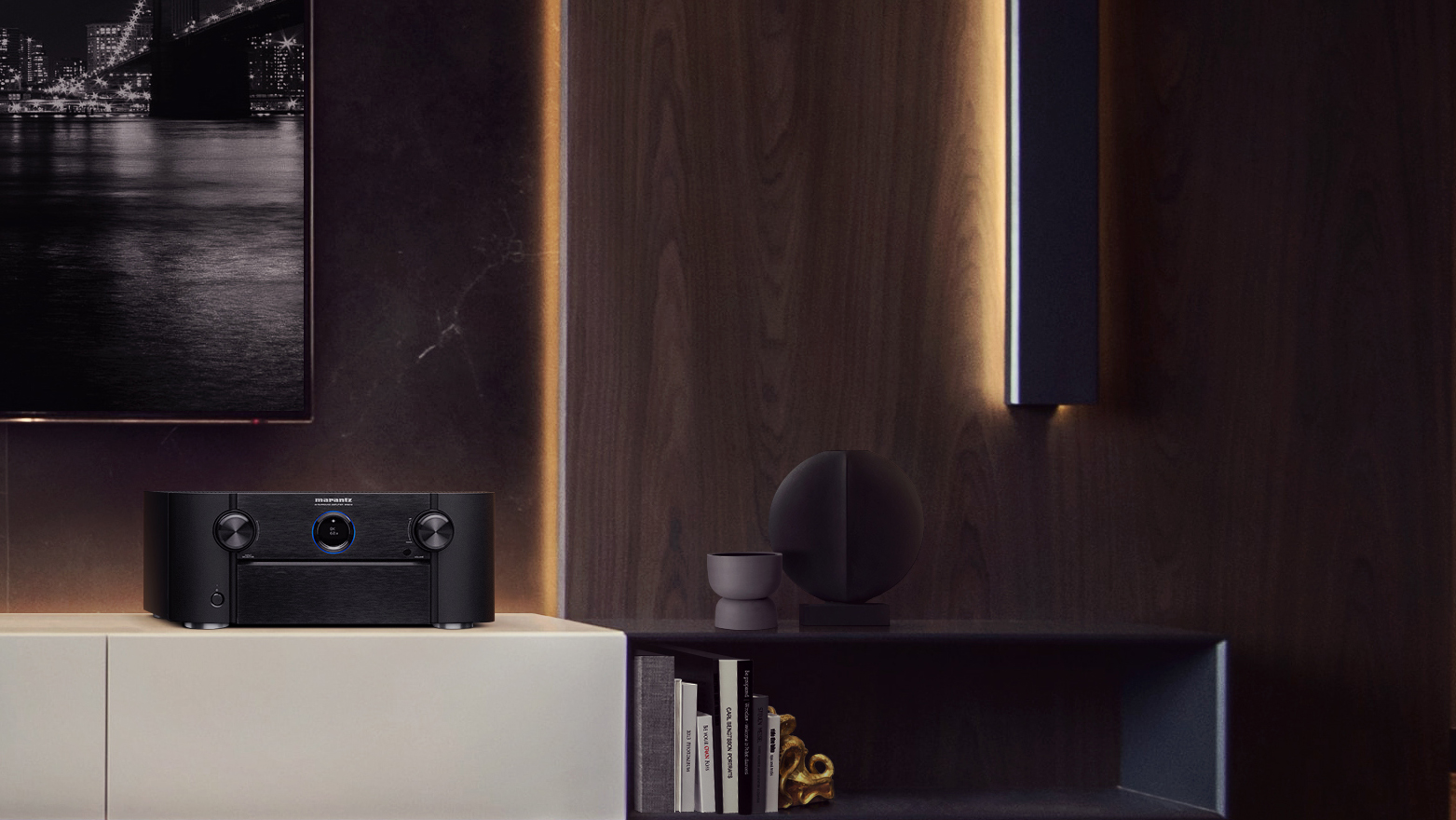Sound+Image Verdict
The Marantz SR8015 sits at a brilliant sweet spot by offering immensely powerful, capable and versatile home cinema management without diving into the territory of diminishing returns.
Pros
- +
Superb performance
- +
Excellent network audio
- +
Flexible speaker support
Cons
- -
No FM, AM or DAB+
Why you can trust What Hi-Fi?

This review originally appeared in Sound+Image magazine, one of What Hi-Fi?’s Australian sister publications. Click here for more information on Sound+Image, including digital editions and details on how you can subscribe.
This AV receiver is rather different – firstly in that it’s not strictly a receiver, because it has no tuner section. But it has, er, quite a lot to compensate, this being a high-level multichannel amplifier absolutely loaded with smarts.
Equipment
We shall return to the tuner thing (because we think it’s interesting), but first let’s get into the core of the Marantz SR8015 multichannel amplifier. Because it’s the real deal. It comes equipped with 11 amplifier channels, each rated at up to 140W output into 8 ohms across the full audio bandwidth, at miniscule (0.05%) levels of total harmonic distortion, two channels driven. The amplifiers can be set to run optimally with 8, 6 or 4-ohm loads on all channels. We suppose that there exist some particularly exotic speakers somewhere in the world which may not work well with this receiver, but as we’ll see, it seemed very comfortable even with quite difficult loads.
The nominal reason for 11 channels is that it supports a set of speakers up to 7.2.4. That is front left, centre and right, then surround left and right, also surround rear left and right, plus two subs and four overhead speakers. Yes, we know that Dolby Atmos and DTS:X are flexible enough to take advantage of even more loudspeakers, but this set-up is what the industry seems to have adopted as a ‘full’ mainstream arrangement.
And there is definitely a case of diminishing returns in the number of channels: 5.1 is enormously better than 2.0 with appropriate content, 7.1 is a little better than 5.1, and 5.1.2 or 5.1.4 is markedly better. Going from 7.1.4 to something higher will provide only very subtle improvements unless you’re dealing with complex or large seating arrangements.
There are the usual flexible arrangements available for the amplifier channels. You can redirect a couple to biamplify the front speakers, or set a couple to drive a second zone. In fact, a third zone is also offered by this amplifier, along with a dedicated HDMI output for a second zone, a dedicated composite video for a second zone, and the ability to reassign the component video output to another zone.

Yes, this amplifier still has plenty of composite and component video inputs, including a composite video input on the front panel in case you... well, perhaps you want to briefly plug in an old VCR to play an ancient tape? The amplifier includes video conversion capabilities: the component and composite video
inputs can both be converted to HDMI and upscaled all the way to the max, though only if the input is 480i/60 or 576i/50. To see higher resolutions sent to the component video inputs, you’ll have to plug the component video outputs into your TV... assuming it’s a model that still supports component video.
As for HDMI inputs, there are plenty of those. And one of them is special: it supports 8K video at up to 50/60p, and 4K at up to 100/120p. That’s for your latest-generation gaming machine. Doubts have been cast about the ability of the first generation of HDMI chips in AV receivers and amplifiers when it comes to handling 100/120Hz 4K and 8K in all its incarnations, such as with HDR encoding. Time will reveal the extent of this. All HDMI input resolutions can be upscaled to anything higher, all the way up to 8K.
The latest hi-fi, home cinema and tech news, reviews, buying advice and deals, direct to your inbox.
There are plenty of other inputs, including eight analogue stereo, one of them on the front panel. And that doesn’t include the phono input, suitable for moving-magnet cartridges. There are also two optical digital audio inputs, plus a couple of coaxial ones.
And, of course, there are plenty of network capabilities, along with Bluetooth. A couple of antennas can be screwed onto the rear of the unit for Bluetooth and Wi-Fi reception. The Bluetooth works both ways: you can connect your phone to the amplifier to play back audio, or you can connect the amplifier to a set of Bluetooth headphones for quiet, wireless, audio enjoyment. We shall return to the network stuff.
Now, this tuner thing. Marantz receivers typically have an FM and an AM band, but no DAB+ capability. This being 2021, and the bulk of Australians now having access to digital radio, we reckon that DAB+ is a useful part of a complete home entertainment experience. While FM can also be a fine source, we can’t say we mourn the lack of an analogue tuner in this unit. But it did get us to wondering... are component tuners still a thing? It turns out that they are, even though few are available from the more famous consumer electronics producers. Component-style DAB+/FM tuners are still available in Australia from Rotel, Sangean, Redback
and a few others.
A couple of other points worth mentioning about the Marantz SR8015 amplifier. Clearly this is a premium build. Two markers: it weighs 17.6kg. Weight is often a good proxy for build quality. The other is an ample use of copper, including plating on the bottom panel and all the exposed screws.
There’s a small round display on the front panel which is visible all the time. This typically displays the selected input and the volume level. More information is available on the larger rectangular display, which is normally hidden behind a fold-down panel.
Of course, the Marantz SR8015 supports all current advanced audio standards: Dolby Atmos, DTS:X Pro and also Auro 3D. That last involves you moving your loudspeakers to different positions, including a ‘voice of God’ speaker directly overhead, so we didn’t test it. We’d just note that Auro 3D is an extra-cost option on some of Marantz’s lesser equipment.
A new one is the IMAX Enhanced certification. It seems that IMAX and DTS have developed a set of rather high-end performance standards for video and sound. The Marantz SR8015 meets those standards. While Sony Pictures is championing IMAX Enhanced content on 4K Blu-rays, the benefits so far seem to us to be minimal, limited in the visual domain to IMAX remastering technology which aims to reduce noise and grain under the filmmaker’s guidance.
Setting up
On first start-up, the Marantz SR8015 amplifier offers a wizard to guide you through. This can go as deeply into things as how to connect your speaker wires to its terminals, but you can skip the bits that you know. Ultimately it leads you to the Audyssey MultEQ XT32 calibration system. This did a good job with one of our speaker systems, and an adequate job on the other (as we’ll see, we switched the front stereo speakers part way through the test). In the latter case, it decided that our giant floorstanders were small speakers and set the crossover to 60Hz. But they’ll deliver 20Hz, so we figure some room mode must have tricked Audyssey.
One of the good things about Audyssey is that you can manually change speaker sizes – making our speakers large instead of small – and it will apply the EQ it has determined to the newly enabled bass response. That’s what we did.
As always we suggest you make sure that
both Audyssey Dynamic Volume and Dynamic EQ are switched off. Or play with them if you like, but they are pretty much antithetical to high fidelity.

Performance
We did most of our listening with our regular speakers: a 5.1.4 system. The result? Superb! We doubt very much that we drew even half the power available from the Marantz SR8015 amplifier, and the sense was certainly one of limitless power.
The amplifier made our whole speaker system sing in unison. Surround imaging was basically as good as it gets, and that included overhead content, whether derived from DTS:X or Dolby Atmos encoding, or simply extracted from 5.1- or 2.0-channel content by Dolby Surround processing.
When we deploy the word ‘flawless’, there really isn’t much more to say, is there? Surround performance: flawless.
We did our stereo music listening using old-school analogue with a Rega Planar 3 turntable and Rega Exact cartridge, and streaming digital audio from our network storage and streaming services. In both cases, we hit the ‘Pure’ button on the remote control. That switches out all processing – EQ, crossovers, the works – for what turned out to be a pretty decent audiophile performance.
After spending quite a bit of time using this amplifier with our regular loudspeaker set-up, we switched out our much-loved but relatively undemanding KEF R300 front speakers and replaced them with our more demanding VAF Research Signature i93 floorstanders with their 3-ohm nominal impedance and their response flat down to 21Hz. The Marantz amplifier proved utterly comfortable with them, controlling their potentially loose bass, keeping it in line, and driving them to wonderfully high levels without a hint of distress.
Networked music
The network and Bluetooth capabilities are pretty much standard for Marantz, being bestowed by the HEOS module within, although more inputs are available for sharing. We ran our favourite high-resolution music – up to 24 bits and 192kHz sampling, and double-rate Direct Stream Digital – into this amplifier, with highly enjoyable results.
For the most part we used the HEOS app to send the music. HEOS is, of course, an advanced multiroom system so you can add sound throughout your home with compatible speakers and gear. The receiver also supported Spotify and TIDAL, although it did not take full advantage of the Master level high-resolution versions of music on TIDAL, since it does not support MQA.

Verdict
The Marantz SR8015 is pretty much as good as you can get in a home cinema multichannel amplifier, unless you’re prepared to leap to the units that cost 10s of thousands of dollars. In short, it’s brilliant.
Sound+Image is Australia's no.1 mag for audio & AV – sister magazine to Australian Hi-Fi and to the UK's What Hi-Fi?, and bestower of the annual Sound+Image Awards, which since 1989 have recognised the year's best hi-fi and home cinema products and installations. While Sound+Image lives here online as part of our group, our true nature is best revealed in the print magazines and digital issues, which curate unique collections of content each issue under the Editorship of Jez Ford, in a celebration of the joys that real hi-fi and high-quality AV can bring. Enjoy essential reviews of the most exciting new gear, features on Australia's best home cinemas, advice on how to find your sound, and our full Buying Guide based on all our current and past award-winners, all wrapped up with the latest news and editorial ponderings. Click here for more information about Sound+Image, including links to buy individual digital editions and details on how best to subscribe.


